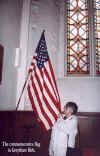|
Early Presbyterians in America – and the Declaration of Independence.
An unnamed minister from
Ulster is recorded as working his ministry in Maryland in 1668. The Rev
William Trail of Lifford went to Maryland in 1682 and officiated there for
several years before returning and becoming minister at Borthwick,
Scotland. The Rev John Makie, from St Johnston, Scotland went there in
1690 and in Delaware the Rev Samuel Davis, from Ireland, ministered to a
growing congregation. In 1705 another Irishman, John Hampton from Burt,
joined the ministry in America. Thus by 1706 Frances Makemie was able to
organise the first American Presbytery – that of Philadelphia.
Rev Francis MaKemie
(1658-1708) is usually credited with being the first to organise
Presbyterianism in America although it must be said that his task was made
easier by the endeavours of others before him. He was licensed in 1682 by
the Lagan Presbytery and went first to the West Indies before arriving in
the American colonies about 1684. His was not an easy task, not only
having a widespread congregation, but hindered by the local governors who
enforced the English laws according more to their whim than the statute. McKemie was arrested in January 1707 by the Deputy Governor in New
York, an Episcopalian by faith, for allegedly preaching without authority
– choosing to ignore the Toleration Act.
Yet another Ulsterman to
make his contribution to America was William Tennent, later to be called `
the father of Presbyterian colleges in America`. In 1716 he founded
his famous `Log College` at Neshaminy which soon gained an enviable
reputation and said to resemble ” one of the school of the
prophets more than any seminary.” He was followed in 1718 by the Rev James
McGregor, minister of Aghadowey, who with members of his congregation from
Macosquin and around Londonderry and Coleraine, established the town
of Londonderry in New Hampshire. So began a new phase among the
Ulster-Scots settlers in America in which some 300,000 discontented
Presbyterians from Ulster settled in the New World between 1717 and
1776.
The early years of the 18th
century was one of continuous physical disaster that impacted the already
struggling farmers who were having problems with tenancies. Many tenancies
were for two or three lives thus by the early 18C the tenancies of the
Plantation settlers were subject of review, while any renewal invariably
meant a substantial increase in rents This description from
Ulster Sails West by William F. Marshall. Baltimore, MD:
Genealogical Publishing Co., Inc. 1950. pg 10-11: sets
out the dreadful state of affairs.
“It is not, however,
contended here that religious intolerance was the only factor or even the
only important factor leading to emigration. There were six years of
drought between 1714 and 1719. There was disease that caused a high
death-rate in sheep in 1716. There was an outbreak of small-pox in
1718. There was a scarcity of silver and copper coin that hampered
trade. The woollen industry had languished, and the linen trade was
not flourishing. There were three bad harvests in 1725, 1726, and
1727, that in 1728 the price of food was higher than in living
memory and the minister of Templepatrick declared that there was not seed enough to sow the ground. There was the great frost in 1739, followed by famine and disease, and Gordon states that in 1740 the mortality caused by scanty and improper food was very high. There was a failure of the potato crop in 1756-7. Then there were the very high rents the consequent increase in tithes….”
Another important factor was that increased rents also meant increased tithes (usually related to the value of the land which they had improved) which were paid to the Church of Ireland, much to the chagrin of the Presbyterian farmers.
The tide of migrants to
America gathered strength from about 1729 and by the second quarter of the
eighteenth century it is estimated that some 12,000 people annually
left Ulster`s shore. In the five years 1768-73 it was computed that Ulster
lost ` one fourth of its trading cash, and the like proportion of the
manufacturing people`. The vast majority were Presbyterians, driven by
intolerant landlords, prejudice and bigotry to take their chances in the
New World. It is ironical, perhaps even justice, that the nation that
denied them the means of earning an honest living would be harshly
punished in the latter years by these same men prominent in wresting
America from the rule of Britain. In that struggle Presbyterian ministers
– John Rodgers, James Caldwell, Alexander M`Whorter, George Duffield and
Patrick Allison were all sons of Ulstermen.
Within the church it was
1752 before the supply of a permanent preacher would be met in America,
meanwhile the Rev John Cuthbertson was diverted from his appointment to
America to preach in Ireland. Cuthbertson soon went to America landing in
Pennsylvania in August 1751 then to spend the next 22 years visiting the
Societies and preaching to the Presbyterians in Pennsylvania and New York.
 So So
a new link was forged that would see the Ulster Scot Presbyterians making
their own Declarations of Independence such as ` The Hanover Resolves ` in
Lancaster Co., Pennsylvania on 4 June 1774 ; and ` The Mecklenburg
Declaration`, at Charlottetown, North Carolina on 31 May 1775. From these
came the format that Thomas Jefferson used in preparing another Covenant –
the Declaration of Independence 4 July 1776. It is no coincidence that in
1970 a commemorative flag was presented to Greyfriars Kirk, the `home` of
the Covenanters, by the United States Consul marking the fact that
the church was consecrated in 1620 – the same year the Pilgrim
Fathers landed in the New World.
|